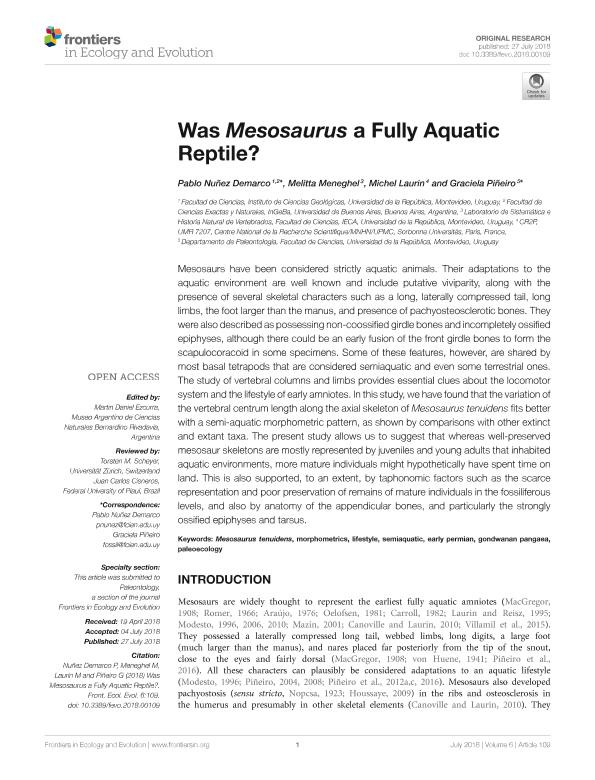Mostrar el registro sencillo del ítem
dc.contributor.author
Núñez Demarco, Pablo Andrés

dc.contributor.author
Meneghel, Melitta
dc.contributor.author
Laurin, Michel
dc.contributor.author
Piñeiro, Graciela
dc.date.available
2019-10-30T20:12:45Z
dc.date.issued
2018-07-27
dc.identifier.citation
Núñez Demarco, Pablo Andrés; Meneghel, Melitta; Laurin, Michel; Piñeiro, Graciela; Was Mesosaurus a Fully Aquatic Reptile?; Frontiers Research Foundation; Frontiers in Ecology and Evolution; 6; 109; 27-7-2018; 1-25
dc.identifier.issn
2296-701X
dc.identifier.uri
http://hdl.handle.net/11336/87709
dc.description.abstract
Mesosaurs have been considered strictly aquatic animals. Their adaptations to theaquatic environment are well known and include putative viviparity, along with thepresence of several skeletal characters such as a long, laterally compressed tail, longlimbs, the foot larger than the manus, and presence of pachyosteosclerotic bones. Theywere also described as possessing non-coossified girdle bones and incompletely ossifiedepiphyses, although there could be an early fusion of the front girdle bones to form thescapulocoracoid in some specimens. Some of these features, however, are shared bymost basal tetrapods that are considered semiaquatic and even some terrestrial ones.The study of vertebral columns and limbs provides essential clues about the locomotorsystemand the lifestyle of early amniotes. In this study, we have found that the variation ofthe vertebral centrum length along the axial skeleton of Mesosaurus tenuidens fits betterwith a semi-aquatic morphometric pattern, as shown by comparisons with other extinctand extant taxa. The present study allows us to suggest that whereas well-preservedmesosaur skeletons are mostly represented by juveniles and young adults that inhabitedaquatic environments, more mature individuals might hypothetically have spent time onland. This is also supported, to an extent, by taphonomic factors such as the scarcerepresentation and poor preservation of remains of mature individuals in the fossiliferouslevels, and also by anatomy of the appendicular bones, and particularly the stronglyossified epiphyses and tarsus.
dc.format
application/pdf
dc.language.iso
eng
dc.publisher
Frontiers Research Foundation

dc.rights
info:eu-repo/semantics/openAccess
dc.rights.uri
https://creativecommons.org/licenses/by/2.5/ar/
dc.subject
MESOSAURUS TENUIDENS
dc.subject
MORPHOMETRICS
dc.subject
IFESTYLE
dc.subject
SEMIAQUATIC
dc.subject
EARLY PERMIAN
dc.subject
GONDWANAN PANGAEA
dc.subject
PALEOECOLOGY
dc.subject.classification
Paleontología

dc.subject.classification
Ciencias de la Tierra y relacionadas con el Medio Ambiente

dc.subject.classification
CIENCIAS NATURALES Y EXACTAS

dc.title
Was Mesosaurus a Fully Aquatic Reptile?
dc.type
info:eu-repo/semantics/article
dc.type
info:ar-repo/semantics/artículo
dc.type
info:eu-repo/semantics/publishedVersion
dc.date.updated
2019-10-15T15:19:56Z
dc.journal.volume
6
dc.journal.number
109
dc.journal.pagination
1-25
dc.journal.pais
Suiza

dc.description.fil
Fil: Núñez Demarco, Pablo Andrés. Consejo Nacional de Investigaciones Científicas y Técnicas. Oficina de Coordinación Administrativa Ciudad Universitaria. Instituto de Geociencias Básicas, Aplicadas y Ambientales de Buenos Aires. Universidad de Buenos Aires. Facultad de Ciencias Exactas y Naturales. Instituto de Geociencias Básicas, Aplicadas y Ambientales de Buenos Aires; Argentina
dc.description.fil
Fil: Meneghel, Melitta. Universidad de la República. Facultad de Ciencias; Uruguay
dc.description.fil
Fil: Laurin, Michel. Universidad de la República. Facultad de Ciencias; Uruguay
dc.description.fil
Fil: Piñeiro, Graciela. Universidad de la República. Facultad de Ciencias; Uruguay
dc.journal.title
Frontiers in Ecology and Evolution
dc.relation.alternativeid
info:eu-repo/semantics/altIdentifier/url/https://www.frontiersin.org/article/10.3389/fevo.2018.00109/full
dc.relation.alternativeid
info:eu-repo/semantics/altIdentifier/doi/http://dx.doi.org/10.3389/fevo.2018.00109
Archivos asociados
